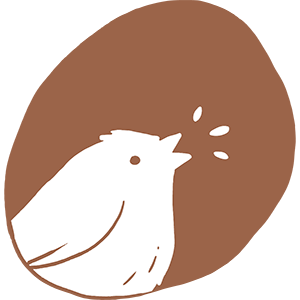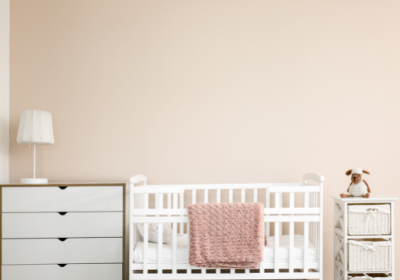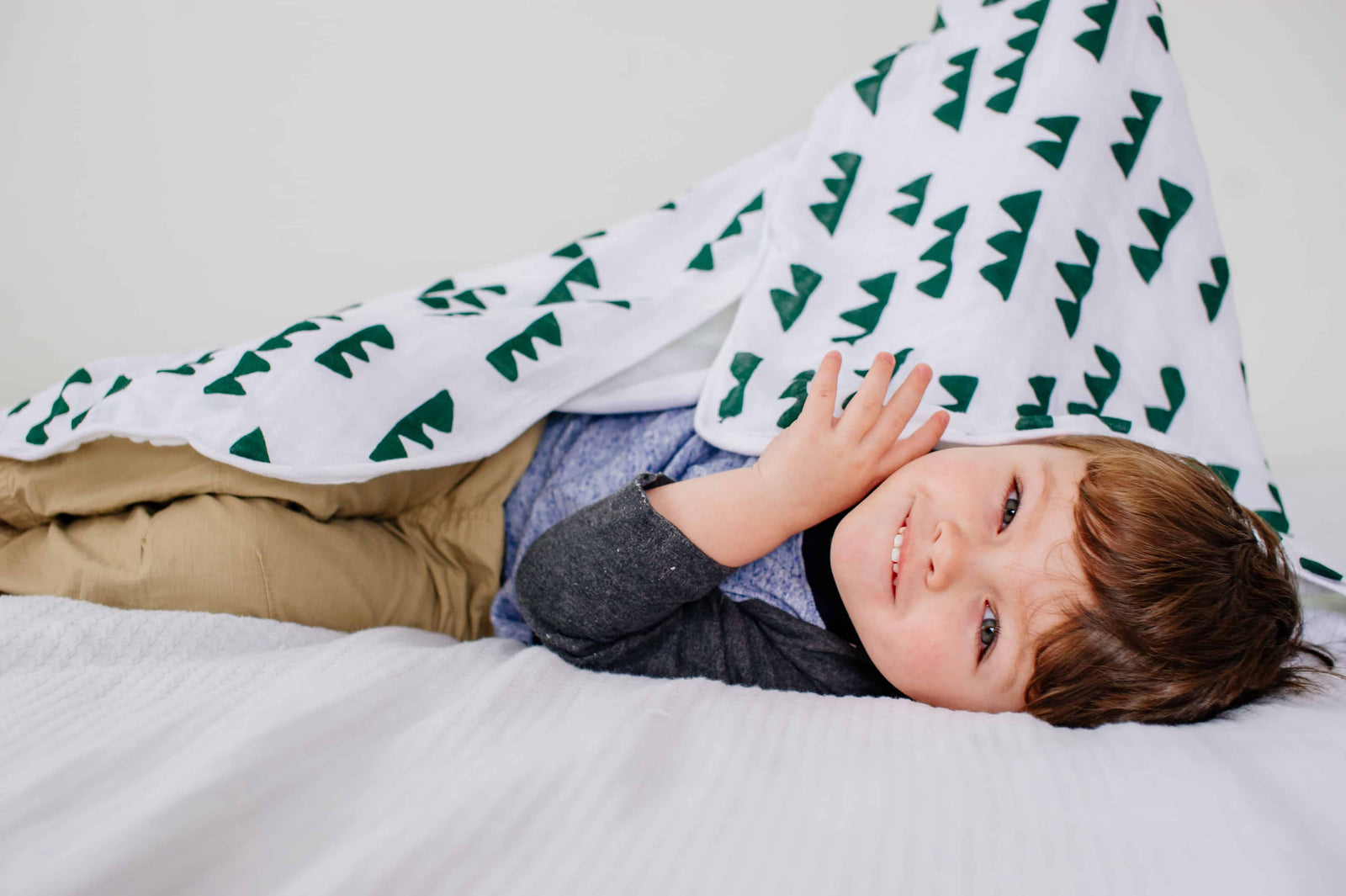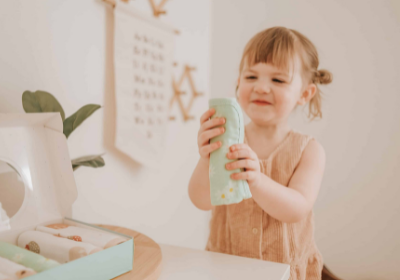For the first couple of months of your baby’s life, a blanket will always be nearby. Whether you need to swaddle or comfort your baby, keep them warm, clean them up, or cover up while nursing, it’s safe to say you will use at least a blanket or two each day. As the months go by, babies typically become attached to their favorite type of blanket and may carry it around and sleep with it well into childhood. Choosing the right assortment of baby blankets to stock in the nursery is important: you need something safe, comfortable, and made with high-quality materials.
Before we get started, we want to emphasize that while they have plenty of uses, loose blankets should never be in the crib while your baby is sleeping. You can introduce a blanket in the crib around 12-18 months. Until then, keep them warm with swaddles, sleep sacks, or warm pajamas.

Introduce blankets in your baby's crib at 12-18 months
The Different Types of Blankets
Swaddle Blankets
Swaddling your baby is one of the best ways to keep them warm while maintaining a safe sleeping environment and reducing the risk of SIDS. Keep them cozy and calm their startle reflex with our organic-certified bamboo muslin blankets. Swaddling blankets are also extremely versatile due to their lightweight, quick-drying material and large size. Use them as a stroller cover, nursing cover, play mat, security blanket, and, of course, swaddle.

Swaddling helps reduce the risk of SIDS
Sleep Sack
Not all babies like to be swaddled, and sleep sacks are essentially wearable blankets that pose no risk of covering your baby’s face during the night. Our sleep sacks (available in four sizes) are made from bamboo to keep your baby cool in the summer and warm in the winter.

Wearable blankets like sleep sacks lessens the risk of covering your baby's face
Toddler Blankets
What’s a toddler blanket? Well, it’s whatever blanket your toddler has grown particularly obsessed with- the one you want to have a few back-ups of in case of emergency. We’ve found that toddlers are partial to our unisex bamboo muslin blankets.

Choose gender-neutral prints, so younger siblings can still use it
Receiving Blankets
These are smaller than your typical swaddling blankets and perfect for newborn care- swaddling, tummy time, cleaning spit-up, and keeping warm with a breathable, thin fabric. The blanket dimensions are typically 30×30 inches, whereas swaddling blankets are around 47×47 inches.

Use swaddling blankets as receiving blankets
Quilts
Quilts for babies and toddlers are a beautiful keepsake, but they’re not for use in cribs. They work well to lay down on the floor or ground while your baby is playing or to display in the nursery and one day use for a toddler bed.
Quilt is best use as a keepsake and display
Weighted Blankets
If you’re wondering about the safety of weighted blankets, they are not considered safe until your child reaches two years old. At that point, if you think your child could benefit from using a weighted blanket, consult your pediatrician, and be sure to purchase the right size and weight. Doctors also do not recommend weighted sleep sacks for babies, as they may increase the risk of overheating and prohibit breathing.
Use weighted blankets for children over two years old
Crocheted Blankets
You may receive a crocheted blanket from a friend or family member, and while they’re nice for keeping warm, tiny baby toes and fingers may get caught in the holes, so keep an eye out. The thicker fabric of crocheted blankets is better for use as a play mat or stroller cover, instead of swaddling or, of course, sleeping.
Crocheted blankets are best used as play mats
How many blankets should I have on hand?
This will largely depend on the weather in your area, your storage space, and your personal preference. Some moms feel better when they have plenty of back-ups, while others prefer a minimalist approach. As a baseline, you likely want to start with:
- 2 sleep sacks
- 1-2 receiving blankets
- 1-2 muslin swaddle blankets
- 1 thicker blanket (such as a Minky blanket or crocheted blanket) or quilt
If you find yourself running out before laundry day, you can always add a couple more to your stash. Around 8-10 months, many babies will have a lovey or security blanket. It’s a good idea to buy a few extras at that point because they will put a lot of wear and tear on it! Experts do not recommend laying baby to sleep with a blanket until 12-18 months.

Invest in blankets and sleep sacks that do not irritate baby's skin
Choosing the Best Breathable Fabrics
Choosing the appropriate fabric is never more crucial than when you have a newborn for two reasons. You need to reduce the risk of suffocation by creating safe sleeping environments, and you need to treat their sensitive skin with care. Babies have delicate skin that can be prone to drying out, rashes, and eczema. Blankets should never be in the crib while they sleep, and you want to use caution when covering them up in their swing or baby seat.
A hypoallergenic, natural, and breathable fabric is the best way to keep them safe and healthy. Choosing a fabric that is organic-certified and CPSC (Consumer Product Safety Commission) compliant will ensure you get the best product possible.
Here are the different fabrics you may have to choose from:
- Bamboo Muslin- Bamboo is the ideal material for babies: it’s a moisture-wicking, temperature-regulating, extremely durable natural fabric. Its smooth, round fibers create a buttery soft material that is easy on even the most sensitive skin. We use 70% bamboo and 30% muslin to create irresistibly soft swaddles that can also hold up after multiple washings.
- Organic cotton- It’s hard to go wrong with cotton blankets, whether it’s muslin, jersey knit, or flannel. Cotton is a natural material that’s soft, breathable, hypoallergenic, and machine-washable.
- Fleece- Fleece makes for a warm and cozy blanket. It also dries quickly. However, the thick material may cause overheating, and they aren’t the best material for sleeping or swaddling.
- Wool- Another natural fabric with moisture-wicking properties, wool will keep your baby warmer than just about any other blanket. It’s also naturally flame-retardant, stain-resistant, and water-repellant.
- Cashmere- Personalized cashmere blankets make lovely (and luxurious) gifts for babies, but you may be hesitant to use them for wiping spit-up or laying on the ground.
- Minky- Minky is a polyester knit fabric that’s incredibly soft to the touch. It’s often used for stuffed animals and toddler blankets but isn’t very breathable.










Leave a comment (all fields required)